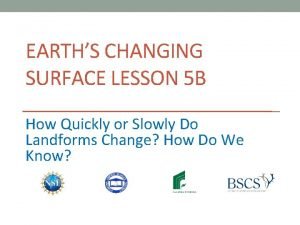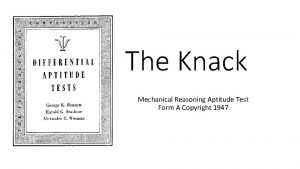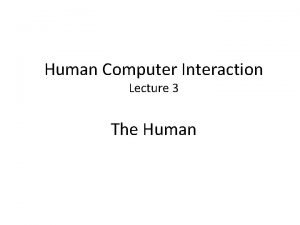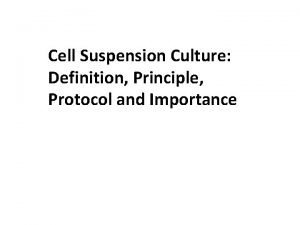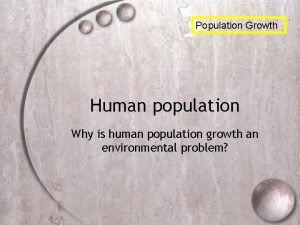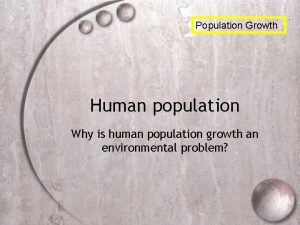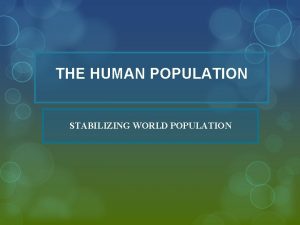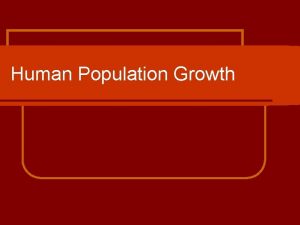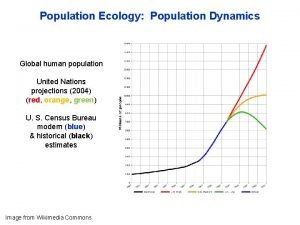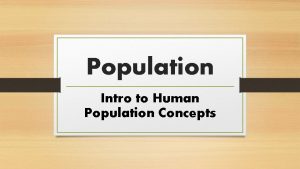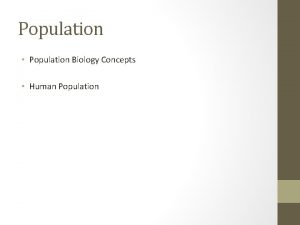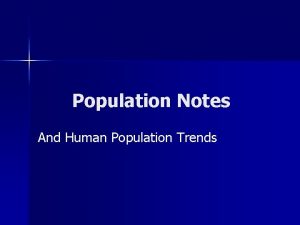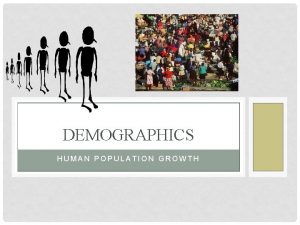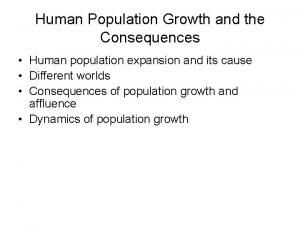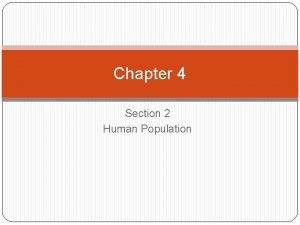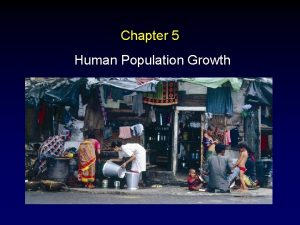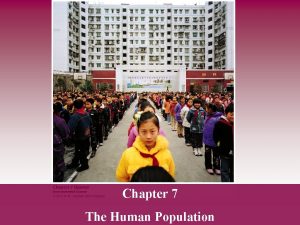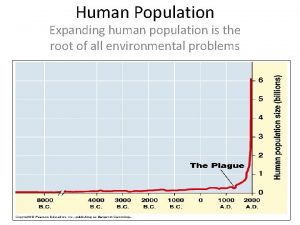HUMAN POPULATION History n n Has grown slowly































- Slides: 31

HUMAN POPULATION

History n n Has grown slowly during most of earths history Last 200 years, has experienced rapid exponential growth J- shaped curve S- shaped curve

Exponential growth Carrying Capacity – number of organism that can be supported in a given area n The earths population is growing at a very fast rate, currently at 1. 14% per year.

n 1. 2. 3. Factors for the increase over history: Ability to live in different habitats and or climate zones Evolution of agriculture Development of sanitary conditions, antibiotics, and vaccines

5 most populous countries (2013) 1. 2. 3. 4. 5. China – 1. 35 billion India – 1. 2 billion USA – 316 million Indonesia – 251 million Brazil – 200 million

Factors affecting population size 1. 2. 3. Number of births (birth rate) – number of live births per 1000 people in a given year Number of deaths (death rate) – number of deaths “ “ Migration (immigration or emigration)

n n n Fertility – number of children born to a women during her lifetime Replacement-level fertility – number of children a couple must have to replace themselves Need to average 2. 1 children per women for 50 years for population to level off.

Factors affecting birth rates 1. 2. 3. 4. 5. 6. Importance of children in the labor force. Cost of raising and educating Availability of private and public pension systems Urbanization Average of marriage Availability of reliable

Factors affecting death rate 1. 2. 3. 4. Increased food supplies Better nutrition Medical advances – immunization and antibiotics Safe water and sanitation

Migration Immigration –movement in Emigration – movement out n Why move? ? n Jobs, economic improvements n Religious persecution n Ethnic conflicts n Wars n Environmental degradations (water shortage, erosion etc…)

n n Since 1820, the U. S. has admitted twice as many immigrants and refugees as all others combined. Prior to 1960 – most immigrants came from Europe After 1960 – most come from Latin America and Asia Large push to reduce immigration • One Reason – to reduce the nations enormous environmental problems

Age Structure n n Age structure – distribution of males and females in each age group in the worlds population Age structure graphs can have a rapid, slow, zero, and negative growth rate

Expanding, Stable, Declining



n n n n 29 % of world population is 15 or younger More in developing countries than developed countries This high level of youth fuels rapid population growth The larger population of youth, the larger the adult population will be in the future This puts a strain on resources Example – Rwanda 1950 -1993 – population tripled Demand for fire wood, lead to burning of crops, lose of soil fertility, to less food

n n 1994 – President killed in plane crash One ethnic group (Hutus) killed an est. 800, 000 (Tutsi) in 100 days.

n n Rapid population decline is also bad. Leads to economic and social problems Lose of workers for jobs and revenue from spending which has an effect on the economy This may also divide people

Solutions 1. Demographic transition – a hypothetical change in population n As countries become industrialized, death rates, then birth rates drop 2. Family Planning – educational and clinical services that help potential parents n Help with birth control, birth spacing, and health care

This prevents unplanned births and also abortions 3. Empowering women n 3 keys a. Education b. Paying jobs outside of the home c. No suppression of rights n

FACTS n Women make up half of the world population n Account for 2/3 of all hours worked n Receive only 10% of worlds income n Own less than 2% of the land n Make up 70% of the poor n Make up 60% of worlds illiterate adults

Urban Sprawl When growth of low density development on the edges of cities and towns gobbles up the surrounding country side Example – Las Vegas, 1970 -2004, population increased from 463, 000 to 2 million and rising n


Problem with Urban Sprawl 1. 2. 3. 4. 5. 6. 7. 8. 9. 10. Loss of cropland, forests, wetlands Increased soil erosion Increased road kill Weight gain Air and water pollution Increased runoff Increased use of water and resources Global warming Increased flooding Increased crime


U. S. Population n n Approximately 316, 000 people U. S. makes up 4. 5% of the world population, uses 25% of world resources, and creates 25% of the world waste 1790 – first census taken in the U. S. Projected population in 2025 – 349, 000 2. 1 lifetime births per women

5 most populous cities in the U. S. 1. 2. 3. 4. 5. New York City Los Angeles Chicago Houston Philadelphia


U. S. Life Expectancy n n n In the U. S. – 78 yrs of age From 1970 to 2013 life expectancy rose from 70 yrs to 78 yrs. Currently –Women – 80 yrs Men – 75 yrs

Case Study : CHINA Between 1972 and 2000 reduced birthrate from 5. 7 to 1. 8 n HOW : instituted a “one child policy” that gave incentives such as: 1. Extra food 2. Larger pension, salary bonuses 3. Better housing 4. Free health care and school tuition n

Problems n n n Increased forced abortions Female infanticide Sex imbalance in the country
 Shade grown coffee vs sun grown
Shade grown coffee vs sun grown No more lives torn apart
No more lives torn apart Maui coffee association
Maui coffee association All grown up and no place to go
All grown up and no place to go Agriculture in dadra and nagar haveli
Agriculture in dadra and nagar haveli North central plains on a map
North central plains on a map The father of tragedy
The father of tragedy The phrase companionable streams is a
The phrase companionable streams is a Fennec fox fat
Fennec fox fat Emperor tiberius grown
Emperor tiberius grown Chapter 4 population ecology answer key
Chapter 4 population ecology answer key Population ecology section 1 population dynamics answer key
Population ecology section 1 population dynamics answer key Population ecology section 1 population dynamics
Population ecology section 1 population dynamics Population ecology chapter 4 answers
Population ecology chapter 4 answers How does weathering affect plains
How does weathering affect plains Comparative slowly
Comparative slowly Rocky slowly got up from the mat
Rocky slowly got up from the mat Rocky slowly got up from the mat
Rocky slowly got up from the mat Love versus in love
Love versus in love Two roads diverged in a yellow wood figure of speech
Two roads diverged in a yellow wood figure of speech Thickest layer of the earth
Thickest layer of the earth How do landforms change slowly
How do landforms change slowly Loud comparative
Loud comparative Mechanical reasoning test
Mechanical reasoning test Rocky slowly got up from the mat
Rocky slowly got up from the mat Semantic knowledge
Semantic knowledge Slowly by james reeves
Slowly by james reeves Listen slowly summary
Listen slowly summary Information reproduced from memory can be assisted by cues.
Information reproduced from memory can be assisted by cues. Culture definition
Culture definition Beautiful is adverb
Beautiful is adverb An example is the thief was a slimy snake
An example is the thief was a slimy snake





















